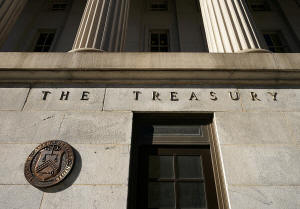Coming flood of US Treasury issuance unsettles some investors after
blazing rally
 Send a link to a friend
Send a link to a friend
 [January 16, 2024] By
Davide Barbuscia [January 16, 2024] By
Davide Barbuscia
NEW YORK (Reuters) - Cracks are forming in the market’s bullish
consensus for bonds, as resurfacing fiscal concerns duel with
expectations that cooling inflation will push the Federal Reserve to cut
interest rates in coming months.
Bullish investors believe the explosive rally bonds experienced in late
2023 is likely to continue into this year, if the Fed loosens monetary
policy as expected. Futures tied to the Fed’s main policy rate on Friday
showed investors pricing in more than 150 basis points of cuts - twice
the amount policymakers projected last month.
Not so fast, say the bears. While expectations for Fed easing may be
driving bond prices now, some believe U.S. Treasury issuance, expected
to nearly double to $2 trillion in 2024, could be a counterweight.
Yields - which move inversely to bond prices - would have to rise from
current levels to entice demand for the flood of new debt, they say.
Such concerns helped drive Treasury prices to 16-year lows when they
intensified in October.
So far, Treasuries have seen a nascent early year selloff, with yields
on the benchmark 10-year Treasury up 16 basis points from their December
lows. Net bearish bets on some long-term Treasury maturities in the
futures market have surged to their highest level since October, data
from the Commodity Futures Trading Commission showed.
"There's really an outrageous amount of U.S. Treasury supply coming from
the lack of fiscal discipline in this country, and we don't necessarily
see who the buyers are," said Chris Diaz, portfolio manager and co-head
of fixed income at Brown Advisory.

That is “going to be a real headwind for the long-end of the market to
continue to rally," he said, as longer-dated maturities are more
vulnerable to fiscal concerns.
In a survey of investors by BofA Global Research, 23% said a bet on
lower Treasury prices was their “highest conviction” trade for 2024,
while 21% said the same for bets on higher Treasury prices.
This was a "moderate reversal" of earlier bullish calls on bonds, the
bank's analysts wrote on Friday.
Worries over U.S. debt sustainability heated up last year, when a credit
rating downgrade by Fitch and higher Treasury issuance plans last summer
fueled a bond selloff that saw the 10-year yield top 5%, its highest
level since 2007.
The slide in bonds also sharpened investor focus on the measure of term
premiums - the additional compensation bond holders demand for the risk
of holding long term debt - which turned positive in September for the
first time in two years.
[to top of second column] |

A view shows a bronze seal beside a door at the U.S. Treasury
building in Washington, U.S., January 20, 2023. REUTERS/Kevin
Lamarque/File Photo

Mounting expectations of a dovish Fed pivot saw bond prices reverse
in the final months of 2023. But some investors believe bonds may
have already factored in future declines in interest rates, making
them vulnerable if fiscal concerns return.
"As we get into 2024, the total level of Treasury issuance is going
to be very critical, whether there's buyers for that paper," said
Tony Roth, chief investment officer at Wilmington Trust. Signs that
inflation is stickier-than-expected could complicate the picture,
Roth said, as inflation erodes the value of future bond payouts,
making so-called real yields less attractive.
FED TO THE RESCUE?
Some of these worries could be offset by the return of the Federal
Reserve as a buyer in the Treasuries market, potentially helping
contain rising long-term yields.
Since June 2022, the Fed has reduced its balance sheet by over $1
trillion through quantitative tightening - a reversal of the massive
central bank bond purchases undertaken to support markets as the
coronavirus hit in 2020. But some Fed officials recently said the
central bank should start considering slowing down and ending the
shrinkage of its bond holdings.
JPMorgan analysts said last week that an earlier-than-anticipated
end of quantitative tightening could improve supply-demand balance
in the Treasury market as fewer government bonds would be sold to
the private sector.
The end of the balance sheet runoff "could lead to duration rallying
and a little more support for 10- and 30-year (Treasuries)," said
Pramod Atluri, fixed income portfolio manager at Capital Group.
A return of the Fed in the market could also, over time, change the
composition of Treasury issuance, with longer-term debt securities
gaining a larger share after increases in their sales were contained
in recent months.
"If the Fed goes back to buying bonds, maybe the Treasury can go
back to issuing in more normal fashion," said John Luke Tyner, fixed
income analyst and portfolio manager at Aptus Capital Advisors. "The
Fed's balance sheet can soak up some of those bonds."
(Reporting by Davide Barbuscia; Editing by Ira Iosebashvili and
Daniel Wallis)
[© 2024 Thomson Reuters. All rights
reserved.]
This material may not be published,
broadcast, rewritten or redistributed.
Thompson Reuters is solely responsible for this content. |